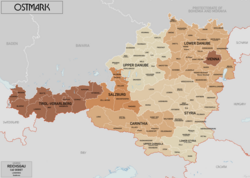
Back النمسا تحت حكم الاشتراكية القومية Arabic Rakousko v nacistickém Německu Czech Østrig under nationalsocialismen Danish Österreich in der Zeit des Nationalsozialismus German Η Αυστρία την εποχή του Εθνικοσοσιαλισμού Greek Austria en la época del nacionalsocialismo Spanish Autriche sous le nazisme French אוסטריה תחת השלטון הנאצי HE ナチス・ドイツ統治下のオーストリア Japanese 나치 독일 치하의 오스트리아 Korean
State of Austria (1938–1940) Land Österreich Reichsgaue of the Ostmark (1940–1942) Reichsgaue der Ostmark Alpine and Danube Reichsgaue (1942–1945) Alpen- und Donau-Reichsgaue | |||||||||
|---|---|---|---|---|---|---|---|---|---|
| 1938–1945 | |||||||||
| Anthem: Deutschlandlied ("Song of Germany") Horst-Wessel-Lied ("The Horst Wessel Song") Proposed: German Rise. A festive song ("Deutsche Auferstehung. Ein festliches Lied") | |||||||||
 Austria within Nazi Germany, 1938 | |||||||||
 Administrative divisions of Austria, 1941 | |||||||||
| Status | Administrative division of Nazi Germany | ||||||||
| Capital | Greater Vienna (de facto) | ||||||||
| Common languages | German | ||||||||
| Demonym(s) | Austrian | ||||||||
| Reichskommissar | |||||||||
• 1938–1940 | Josef Bürckel | ||||||||
| Reichsstatthalter | |||||||||
• 1938–1939 | Arthur Seyss-Inquart | ||||||||
• 1939–1940 | Josef Bürckel | ||||||||
• 1940–1945 | Baldur von Schirach | ||||||||
| Historical era | |||||||||
| 13 March 1938 | |||||||||
| 15 March 1938 | |||||||||
| 10 April 1938 | |||||||||
• Ostmark law | 14 April 1939 | ||||||||
| 13 April 1945 | |||||||||
• Declaration of Independence | 27 April 1945 | ||||||||
• Independence from Germany | 8 May 1945 | ||||||||
| Currency | Reichsmark (ℛℳ) | ||||||||
| |||||||||
| History of Austria |
|---|
 |
|
|
Austria was part of Nazi Germany from 13 March 1938 (an event known as the Anschluss) until 27 April 1945, when Allied-occupied Austria declared independence from Nazi Germany.
Nazi Germany's troops entering Austria in 1938 received the enthusiastic support of most of the population.[1] Throughout World War II, 950,000 Austrians fought for the Nazi German armed forces. Other Austrians participated in the Nazi administration, from Nazi death camp personnel to senior Nazi leadership; the majority of the bureaucrats who implemented the Final Solution were Austrian.[2][3]
After World War II, many Austrians sought comfort in the myth of Austria as being the first victim of the Nazis.[4] Although the Nazi Party was promptly banned, Austria did not have the same thorough process of denazification that was imposed on post-war Germany. Lacking outside pressure for political reform, factions of Austrian society tried for a long time to advance the view that the Anschluss was only an imposition of rule by Nazi Germany.[5] By 1992, the subject of the small minority who formed an Austrian resistance, versus the vast majority of Austrians who participated in the Nazi war machine, had become a prominent matter of public discourse.[6]
- ^ "Austria". encyclopedia.ushmm.org.
- ^ Cymet, David (2012). History vs. Apologetics: The Holocaust, the Third Reich, and the Catholic Church. Lexington Books. pp. 113–114.
- ^ "Austria struggles to come to grips with Nazi past". Australian Broadcasting Corporation. 4 November 2015.
- ^ "Austria post-1945 - Auschwitz".
- ^ Beniston, Judith (2003). "'Hitler's First Victim'? — Memory and Representation in Post-War Austria: Introduction". Austrian Studies. 11 (1): 1–13. doi:10.1353/aus.2003.0018. JSTOR 27944673. S2CID 160319529.
- ^ Steiner 1992, pp. S128–S133.

